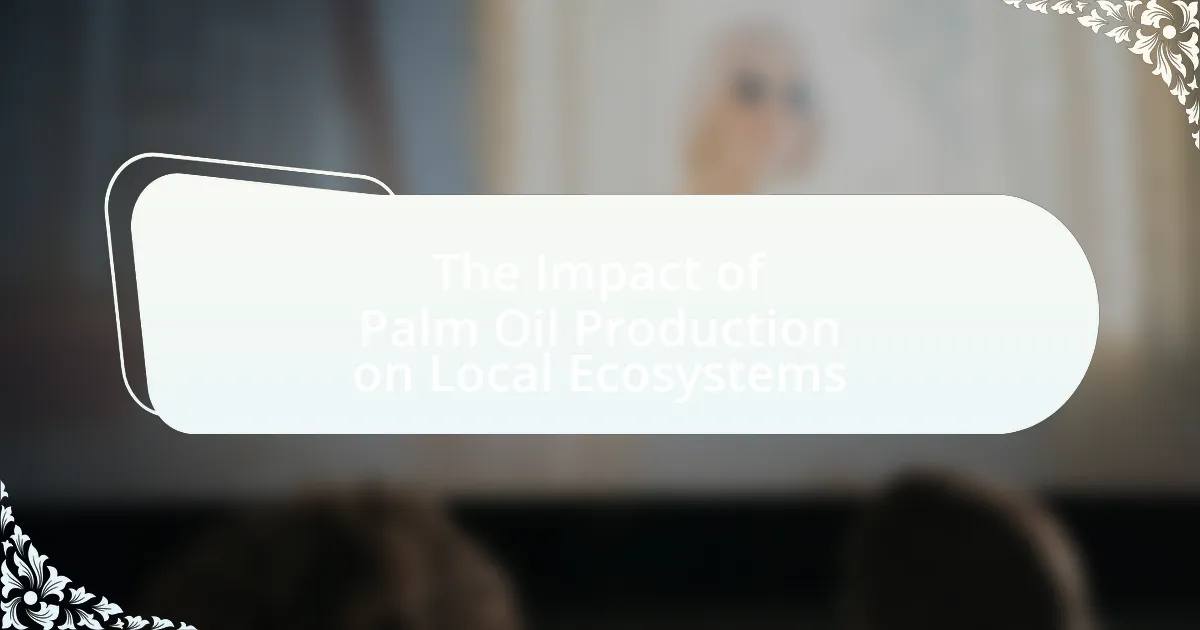The main entity of the article is palm oil production and its impact on local ecosystems. The article outlines how palm oil cultivation leads to significant environmental issues, including deforestation, habitat loss, and a decline in biodiversity, particularly affecting endangered species such as orangutans and Sumatran tigers. It discusses the socio-economic consequences for local communities, including land dispossession and water resource contamination, while also exploring sustainable alternatives and practices that can mitigate these negative effects. The article emphasizes the importance of sustainable palm oil certification and the role of consumers and governments in promoting environmentally responsible practices to protect local ecosystems.

What is the impact of palm oil production on local ecosystems?
Palm oil production significantly disrupts local ecosystems by leading to deforestation, habitat loss, and biodiversity decline. The conversion of forests into palm oil plantations results in the destruction of habitats for numerous species, including endangered ones like orangutans and tigers. According to a study published in the journal “Nature,” approximately 90% of the original forest cover in Indonesia has been lost due to palm oil expansion, which has severe implications for carbon storage and climate regulation. Additionally, the use of pesticides and fertilizers in palm oil cultivation can contaminate local water sources, further harming aquatic ecosystems.
How does palm oil production affect biodiversity?
Palm oil production significantly reduces biodiversity by leading to habitat destruction and fragmentation. The conversion of forests into palm oil plantations displaces numerous species, including endangered ones, and disrupts ecosystems. For instance, the World Wildlife Fund reports that palm oil cultivation has contributed to the decline of species such as orangutans and tigers, as their natural habitats are cleared for agricultural use. Additionally, monoculture practices in palm oil farming diminish genetic diversity among plant and animal species, further threatening ecosystem resilience.
What species are most threatened by palm oil cultivation?
The species most threatened by palm oil cultivation include the orangutan, Sumatran tiger, and Bornean pygmy elephant. These species face habitat loss due to deforestation for palm oil plantations, which has led to significant declines in their populations. For instance, the International Union for Conservation of Nature (IUCN) lists the Sumatran tiger as critically endangered, with habitat destruction being a primary factor. Similarly, the Bornean pygmy elephant’s habitat has shrunk by over 30% in the last few decades due to palm oil expansion, severely impacting their survival.
How does habitat loss from palm oil production influence local wildlife?
Habitat loss from palm oil production significantly reduces local wildlife populations by destroying their natural habitats. This destruction leads to fragmentation of ecosystems, making it difficult for species to find food, mates, and shelter. For instance, studies indicate that orangutan populations have declined by over 50% in regions where palm oil plantations have expanded, as their forest habitats are cleared for cultivation. Additionally, the loss of biodiversity is evident, with many species facing extinction due to the inability to adapt to the altered landscapes. The International Union for Conservation of Nature (IUCN) reports that habitat destruction from palm oil is a critical threat to numerous endangered species, highlighting the urgent need for sustainable practices in palm oil production.
What are the environmental consequences of palm oil plantations?
Palm oil plantations lead to significant environmental consequences, primarily deforestation, loss of biodiversity, and greenhouse gas emissions. Deforestation occurs as vast areas of tropical forests are cleared to make way for palm oil cultivation, resulting in habitat destruction for countless species. According to the World Wildlife Fund, palm oil production is a major driver of deforestation in Southeast Asia, where over 50% of the original rainforest has been lost. This loss of habitat contributes to the decline of endangered species such as orangutans and tigers. Additionally, the conversion of forests to plantations releases stored carbon dioxide, exacerbating climate change; research indicates that land-use changes associated with palm oil can emit up to 1.5 billion tons of CO2 annually. Furthermore, the monoculture practices in palm oil plantations reduce soil fertility and disrupt local water cycles, leading to further ecological imbalance.
How does deforestation for palm oil affect carbon emissions?
Deforestation for palm oil significantly increases carbon emissions by releasing stored carbon dioxide from trees and soil into the atmosphere. When forests are cleared for palm oil plantations, the carbon stored in the biomass of trees and the organic matter in the soil is released, contributing to greenhouse gas emissions. According to a study published in “Nature Climate Change,” land-use changes associated with palm oil production can result in emissions of up to 1.5 billion tons of CO2 annually, exacerbating climate change. This process not only diminishes carbon sinks but also disrupts local ecosystems, further impacting biodiversity and environmental stability.
What role does palm oil production play in soil degradation?
Palm oil production significantly contributes to soil degradation through deforestation and monoculture practices. The clearing of forests for palm oil plantations removes vegetation that protects soil structure and fertility, leading to increased erosion and nutrient loss. Studies indicate that soil organic matter can decrease by up to 50% in areas converted to palm oil cultivation, which negatively impacts soil health and agricultural productivity. Additionally, the use of chemical fertilizers and pesticides in monoculture systems further degrades soil quality, reducing its ability to support diverse plant life and maintain ecosystem balance.
Why is palm oil production a concern for local communities?
Palm oil production is a concern for local communities primarily due to its detrimental effects on land use and livelihoods. The expansion of palm oil plantations often leads to deforestation, which displaces local populations and disrupts traditional farming practices. For instance, in Indonesia, the conversion of forests to palm oil plantations has resulted in the loss of over 24 million hectares of forest since 1990, significantly impacting the communities that rely on these ecosystems for their sustenance and cultural identity. Additionally, the environmental degradation associated with palm oil production, such as soil erosion and water pollution, further threatens the health and economic stability of local communities.
How does palm oil cultivation impact local water resources?
Palm oil cultivation significantly impacts local water resources by altering hydrological cycles and reducing water quality. The conversion of forests to palm oil plantations disrupts natural water flow, leading to increased runoff and decreased groundwater recharge. This change can result in flooding during heavy rains and drought during dry seasons. Additionally, the use of fertilizers and pesticides in palm oil farming contaminates nearby water bodies, harming aquatic ecosystems and reducing the availability of clean water for local communities. Studies have shown that areas with extensive palm oil cultivation experience higher levels of water pollution and altered water availability compared to regions with intact forests.
What are the socio-economic effects of palm oil production on indigenous populations?
Palm oil production has significant socio-economic effects on indigenous populations, primarily leading to land dispossession and economic marginalization. Indigenous communities often lose access to their ancestral lands due to the expansion of palm oil plantations, which disrupts traditional livelihoods such as farming and hunting. For instance, a study by the World Wildlife Fund indicates that in Indonesia, over 1.5 million hectares of land have been converted to palm oil plantations, displacing thousands of indigenous people. This loss of land not only affects food security but also undermines cultural practices tied to the land. Additionally, while palm oil production can create jobs, these are often low-paying and exploitative, failing to provide sustainable economic benefits to indigenous populations.

What are the alternatives to palm oil production?
The alternatives to palm oil production include oils such as soybean oil, sunflower oil, canola oil, and coconut oil. These oils can serve similar culinary and industrial purposes as palm oil while often requiring less land and having a lower environmental impact. For instance, soybean oil is widely used and can be produced on a larger scale in regions like the United States and Brazil, where agricultural practices are more sustainable. Sunflower oil, derived from sunflowers, is another viable option that is less harmful to ecosystems compared to palm oil plantations, which often lead to deforestation and habitat loss. Additionally, canola oil, extracted from rapeseed, is known for its health benefits and lower saturated fat content, making it a popular alternative. Coconut oil, while still having some environmental concerns, is often produced in smaller-scale, traditional farming systems that can be more sustainable than large palm oil plantations.
How do alternative oils compare to palm oil in terms of environmental impact?
Alternative oils generally have a lower environmental impact compared to palm oil, primarily due to less deforestation and biodiversity loss associated with their production. For instance, oils such as sunflower and canola are often cultivated in regions that do not require the extensive land conversion seen with palm oil plantations, which have led to significant habitat destruction in tropical areas. According to a study published in the journal “Nature” by Gibbs et al. (2010), palm oil expansion has been a major driver of deforestation in Southeast Asia, contributing to greenhouse gas emissions and loss of wildlife habitats. In contrast, the cultivation of alternative oils typically involves less intensive land use and can be integrated into existing agricultural systems, thereby mitigating some of the negative environmental impacts associated with palm oil production.
What are the most sustainable alternatives to palm oil?
The most sustainable alternatives to palm oil include coconut oil, sunflower oil, and rapeseed oil. Coconut oil is derived from the fruit of coconut palms, which can be cultivated in a way that minimizes environmental impact. Sunflower oil is produced from sunflowers, which require less land and water compared to palm oil plantations. Rapeseed oil, extracted from rapeseed plants, is also considered sustainable due to its high yield and ability to grow in diverse climates. These alternatives are often produced with lower deforestation rates and reduced greenhouse gas emissions, making them more environmentally friendly options compared to palm oil.
How can consumers make informed choices regarding palm oil alternatives?
Consumers can make informed choices regarding palm oil alternatives by researching the environmental impact and sustainability of various oils. For instance, oils such as coconut, sunflower, and rapeseed can serve as alternatives, but their production methods and land use must be evaluated. Studies indicate that sustainable certifications, like RSPO (Roundtable on Sustainable Palm Oil), can guide consumers toward environmentally friendly options. Additionally, understanding the carbon footprint and biodiversity effects of each alternative helps consumers select products that minimize harm to local ecosystems.
What practices can reduce the negative impact of palm oil production?
Sustainable palm oil production practices can significantly reduce the negative impact on local ecosystems. Implementing agroforestry techniques, which integrate palm oil cultivation with other crops and trees, enhances biodiversity and soil health. Certification schemes like the Roundtable on Sustainable Palm Oil (RSPO) promote environmentally responsible practices, ensuring that palm oil is produced without deforestation and habitat destruction. Additionally, employing precision agriculture techniques minimizes chemical use and optimizes land productivity, reducing the ecological footprint. Research indicates that certified sustainable palm oil can lead to a 30% reduction in greenhouse gas emissions compared to conventional methods, highlighting the effectiveness of these practices in mitigating environmental harm.
How can sustainable palm oil certification help local ecosystems?
Sustainable palm oil certification helps local ecosystems by promoting environmentally responsible farming practices that reduce deforestation and habitat destruction. This certification requires adherence to specific criteria that protect biodiversity, such as maintaining buffer zones around water bodies and conserving high conservation value areas. For instance, the Roundtable on Sustainable Palm Oil (RSPO) certification mandates that producers implement measures to safeguard endangered species and their habitats, which can lead to improved ecosystem health and resilience. Studies have shown that certified plantations can support greater biodiversity compared to non-certified ones, as they often incorporate agroforestry practices that enhance habitat complexity and connectivity.
What role do consumers play in promoting sustainable palm oil practices?
Consumers play a crucial role in promoting sustainable palm oil practices by driving demand for certified sustainable products. When consumers choose products that contain sustainably sourced palm oil, they incentivize companies to adopt environmentally friendly practices and adhere to certification standards, such as those set by the Roundtable on Sustainable Palm Oil (RSPO). This consumer behavior directly influences market trends, as evidenced by a 2018 study indicating that brands committed to sustainable palm oil saw a 30% increase in sales compared to those that did not prioritize sustainability. By making informed purchasing decisions, consumers can significantly impact the palm oil supply chain, encouraging transparency and accountability among producers.

How can we mitigate the impact of palm oil production on local ecosystems?
To mitigate the impact of palm oil production on local ecosystems, implementing sustainable agricultural practices is essential. These practices include adopting agroforestry systems, which integrate palm oil cultivation with other crops and trees, thereby preserving biodiversity and reducing habitat destruction. Research indicates that sustainable palm oil production can reduce deforestation rates by up to 50% compared to conventional methods, as shown in studies by the Roundtable on Sustainable Palm Oil (RSPO). Additionally, enforcing stricter regulations on land use and promoting the use of certified sustainable palm oil can further minimize ecological damage, ensuring that production does not compromise local wildlife and plant species.
What strategies can be implemented for sustainable palm oil production?
Sustainable palm oil production can be achieved through several key strategies, including the adoption of agroforestry practices, certification schemes, and improved land management techniques. Agroforestry integrates palm oil cultivation with other crops and trees, enhancing biodiversity and soil health. Certification schemes, such as the Roundtable on Sustainable Palm Oil (RSPO), set standards for environmentally and socially responsible production, ensuring that palm oil is sourced sustainably. Improved land management techniques, such as precision agriculture and integrated pest management, reduce environmental impact and increase yield efficiency. These strategies collectively contribute to minimizing deforestation, protecting local ecosystems, and promoting sustainable livelihoods for communities involved in palm oil production.
How can agroforestry practices enhance biodiversity in palm oil plantations?
Agroforestry practices can enhance biodiversity in palm oil plantations by integrating diverse plant species and creating multi-layered ecosystems. This approach allows for the coexistence of various flora and fauna, which can lead to increased habitat availability and improved ecological interactions. For instance, studies have shown that agroforestry systems can support a higher number of bird species and beneficial insects compared to monoculture plantations. Research conducted by the World Agroforestry Centre indicates that incorporating shade trees and understory crops in palm oil plantations can significantly increase species richness and abundance, thereby promoting a healthier ecosystem.
What are the benefits of reforestation in palm oil-producing regions?
Reforestation in palm oil-producing regions enhances biodiversity, mitigates climate change, and restores ecosystem services. By reintroducing native tree species, these areas can support a wider range of flora and fauna, which is crucial for maintaining ecological balance. Additionally, reforestation helps sequester carbon dioxide, thereby reducing greenhouse gas emissions and combating global warming. Studies indicate that reforested areas can absorb significant amounts of carbon, with estimates suggesting that tropical forests can sequester up to 1.1 billion tons of carbon annually. Furthermore, reforestation improves soil quality and water retention, leading to better agricultural productivity and resilience against erosion.
What policies can support the conservation of local ecosystems affected by palm oil?
Policies that can support the conservation of local ecosystems affected by palm oil include enforcing sustainable land-use regulations, promoting agroforestry practices, and implementing certification schemes for sustainable palm oil. Sustainable land-use regulations can limit deforestation and habitat destruction, which are critical for preserving biodiversity. Agroforestry practices integrate palm oil cultivation with other crops, enhancing ecosystem resilience and reducing environmental impact. Certification schemes, such as the Roundtable on Sustainable Palm Oil (RSPO), encourage producers to adhere to environmental standards, ensuring that palm oil production does not compromise local ecosystems. These policies collectively contribute to the protection and restoration of habitats, thereby mitigating the adverse effects of palm oil production on local ecosystems.
How can governments enforce regulations on palm oil production?
Governments can enforce regulations on palm oil production through a combination of legal frameworks, monitoring systems, and incentives for sustainable practices. Legal frameworks include establishing laws that require compliance with environmental standards, such as the Roundtable on Sustainable Palm Oil (RSPO) certification, which mandates adherence to specific environmental and social criteria. Monitoring systems involve satellite imagery and on-the-ground inspections to track deforestation and land use changes, ensuring that producers adhere to regulations. Additionally, governments can provide financial incentives, such as subsidies or tax breaks, for companies that adopt sustainable practices, thereby encouraging compliance with environmental regulations. These measures collectively help mitigate the negative impacts of palm oil production on local ecosystems.
What role do NGOs play in advocating for sustainable palm oil practices?
NGOs play a crucial role in advocating for sustainable palm oil practices by promoting environmental conservation and social responsibility within the industry. They engage in awareness campaigns, provide research and data on the ecological impacts of palm oil production, and collaborate with stakeholders to develop and implement sustainable standards. For instance, organizations like the Rainforest Alliance and WWF have established certification programs that set criteria for sustainable palm oil, helping to reduce deforestation and protect biodiversity. These initiatives are supported by evidence showing that sustainable practices can mitigate the negative effects of palm oil cultivation on local ecosystems, such as habitat destruction and loss of biodiversity.
What actions can individuals take to support ecosystem health in palm oil regions?
Individuals can support ecosystem health in palm oil regions by choosing sustainably sourced palm oil products. This action helps reduce deforestation and habitat destruction associated with conventional palm oil production. According to the World Wildlife Fund, sustainable palm oil practices can lead to a 50% reduction in greenhouse gas emissions and protect biodiversity by maintaining natural habitats. Additionally, individuals can advocate for policies that promote sustainable agriculture and support organizations working to restore degraded lands in palm oil-producing areas.

Leave a Reply